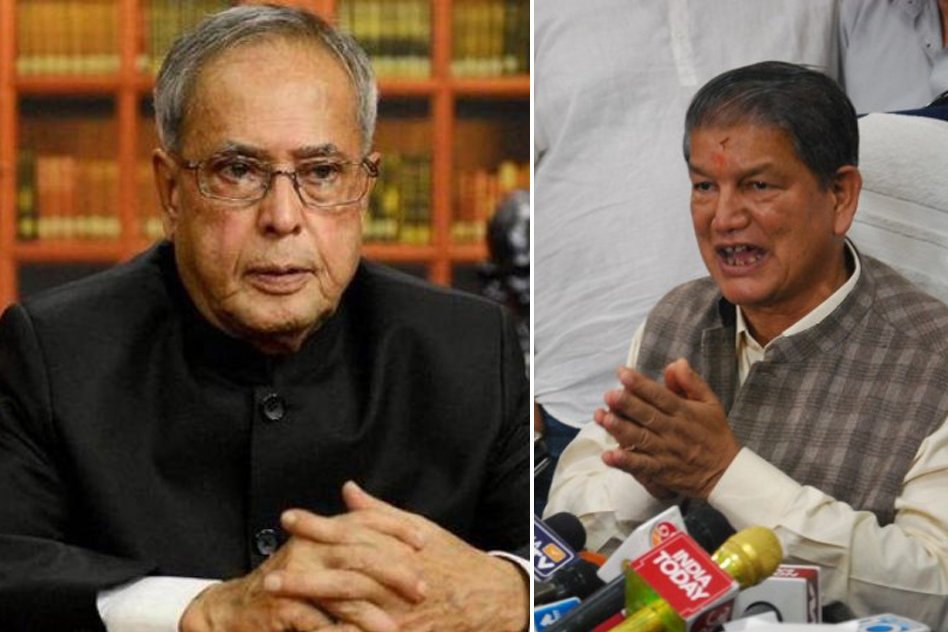Image Courtesy: indiatvnews ibtimes
The state of Uttarakhand was brought under the President’s rule on Sunday on grounds of “breakdown of governance”. The decision comes at a time when the state is the government is facing severe political crisis caused by a rebellion in the ruling Congress party. The Centre viewed the continuance of the incumbent Rawat government was “unconstitutional’ after the speaker had declared that the passing of the Appropriation Bill had been controversial without allowing a division pressed for by 35 MLAs, including nine rebel Congress legislators.
President Pranab Mukherjee signed the proclamation under Article 356 of the Constitution placing the Uttarakhand assembly under suspended animation on the recommendation of the Union Cabinet.
So how is President’s rule implemented?
President’s rule is the imposition of Article 356 of the Constitution of India on a State whose constitutional machinery has failed. It can be described as a situation when the government of the State cannot carry out its responsibility in the accordance with the provisions of the Constitution. During such situations, the State comes under the direct control of the Central government and the executive authority is exercised through the centrally appointed Governor.
What is suspended animation of an assembly?
In the case of a suspended animation, the elected members of an assembly remain as elected but their legislative power of making laws is taken away until further notice from the president. The Parliament takes over the legislative power of the particular state with effect from the declaration of the president’s rule.
Some instances of President’s rule
- Earlier President’s rule was imposed in the state of Arunachal Pradesh as political crisis was triggered after 21 of 47 Congress MLAs in the 60-member House, along with 11 BJP and two Independent MLAs, extended support to the Deputy Speaker and ousted the Speaker and the Chief Minister in two assembly sessions.
- The Supreme Court in January 2006 declared the dissolution of the Bihar assembly as null and void in the Buta Singh case. It held that the governor’s report could not be taken at face value and must be verified by the council of ministers before being used as the basis for imposing President’s rule.
Other states which have come under president’s rule
- Andhra Pradesh (3 times)
- Arunachal Pradesh (2 times)
- Assam (4 times)
- Bihar (8 times)
- Delhi (once)
- Goa (5 times)
- Gujarat (5 times)
- Haryana (3 times)
- Himachal Pradesh (2 times)
- Jammu and Kashmir (7 times)
- Jharkhand (3 times)
- Karnataka ( 5 times)
- Kerala (4 times)
- Madhya Pradesh (3 times)
- Maharashtra (2 times)
- Manipur (10 times)
- Meghalaya (2 times)
- Mizoram (3 times)
- Nagaland (4 times)
- Orissa (6 times)
- Punjab (8 times)
- Rajasthan (4 times)
- Sikkim ( 2 times)
- Tamilnadu (3 times)
- Tripura ( 3 times)
- Uttarakhand (once)
- Uttar Pradesh (9 times)
- West Bengal ( 4 times)
Article 356 gave wide powers to the central government to assert its authority Article 356 gives the Indian constitution unitary character. The misuse of Article 356 is evident from the number of times it has been imposed though the purpose of this article is to give more powers to the central government to preserve the unity and integrity of the nation thereby threatening the federal nature of India. The Indira Gandhi regime and post-emergency Janata Party were noted for this practice. Indira Gandhi’s government between 1966 and 1977 is known to have imposed President’ rule in 39 times in different states.
How was the abuse of article 356 contained?
- R. Bommai v. Union of India (1994) case that the misuse of Article 356 was curtailed. Supreme Court established strict guidelines for imposing President’s rule and hence the number of cases of imposition of President’s rule has come down drastically.
The Logical Indian requests the central government to be cautious in its approach and usage of Article 356. Democracy in India is as delicate as it is complex, for sustained stability balance of power between states and central government is of paramount importance. Article 356 creates an imbalance in that balance of power. Let Article 356 be used wisely in exceptional circumstances.












